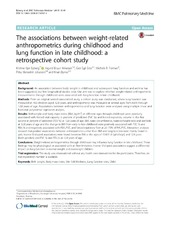| dc.contributor.author | Byberg, Kristine Kjer | en_US |
| dc.contributor.author | Mikalsen, Ingvild Bruun | en_US |
| dc.contributor.author | Eide, Geir Egil | en_US |
| dc.contributor.author | Forman, Michele R. | en_US |
| dc.contributor.author | Júlíusson, Pétur Benedikt | en_US |
| dc.contributor.author | Øymar, Knut | en_US |
| dc.date.accessioned | 2018-01-25T10:45:54Z | |
| dc.date.available | 2018-01-25T10:45:54Z | |
| dc.date.issued | 2018-01-19 | |
| dc.identifier.issn | 1471-2466 | |
| dc.identifier.uri | https://hdl.handle.net/1956/17279 | |
| dc.description.abstract | Background: An association between body weight in childhood and subsequent lung function and asthma has been suggested, but few longitudinal studies exist. Our aim was to explore whether weight-related anthropometric measurements through childhood were associated with lung function in late childhood. Methods: From an original nested case-control study, a cohort study was conducted, where lung function was measured in 463 children aged 12.8 years, and anthropometry was measured at several ages from birth through 12.8 years of age. Associations between anthropometrics and lung function were analysed using multiple linear and fractional polynomial regression analysis. Results: Birthweight and body mass index (BMI; kg/m2) at different ages through childhood were positively associated with forced vital capacity in percent of predicted (FVC %) and forced expiratory volume in the first second in percent of predicted (FEV1%) at 12.8 years of age. BMI, waist circumference, waist-to-height ratio and skinfolds at 12.8 years of age and the change in BMI from early to late childhood were positively associated with FVC % and FEV1% and negatively associated with FEV1/FVC and forced expiratory flow at 25–75% of FVC/FVC. Interaction analyses showed that positive associations between anthropometrics other than BMI and lung function were mainly found in girls. Inverse U-shaped associations were found between BMI at the ages of 10.8/11.8 (girls/boys) and 12.8 years (both genders) and FVC % and FEV1% at 12.8 years of age. Conclusions: Weight-related anthropometrics through childhood may influence lung function in late childhood. These findings may be physiological or associated with air flow limitation. Inverse U-shaped associations suggest a differential impact on lung function in normal-weight and overweight children. | en_US |
| dc.language.iso | eng | eng |
| dc.publisher | BioMed Central | eng |
| dc.relation.ispartof | <a href="http://hdl.handle.net/1956/16887" target="blank">An epidemiological study on the associations between preeclampsia exposure, growth and physical activity in preschool age and subsequent allergy, asthma and lung function in late childhood</a> | |
| dc.rights | Attribution CC BY | eng |
| dc.rights.uri | http://creativecommons.org/licenses/by/4.0 | eng |
| dc.subject | Birth weight | eng |
| dc.subject | Body mass index | eng |
| dc.subject | Skin fold thickness | eng |
| dc.subject | Lung function tests | eng |
| dc.subject | Child | eng |
| dc.title | The associations between weight-related anthropometrics during childhood and lung function in late childhood: a retrospective cohort study | en_US |
| dc.type | Peer reviewed | |
| dc.type | Journal article | |
| dc.description.version | publishedVersion | en_US |
| dc.rights.holder | Copyright 2018 The Author(s) | |
| dc.source.articlenumber | 10 | |
| dc.identifier.doi | https://doi.org/10.1186/s12890-017-0567-3 | |
| dc.source.journal | BMC Pulmonary Medicine | |
| dc.source.40 | 18 | |

